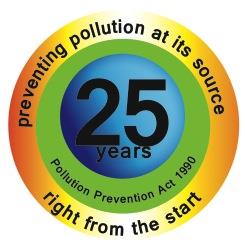Twenty-five years ago, Congress passed the Pollution Prevention Act. Pollution Prevention (P2) Week, celebrated during the third week of September each year (September 21-27, 2015), highlights the efforts of EPA, its state partners, industry, and the public in preventing pollution right from the start.
How can your organization tell the P2 story all year long? Here are some ideas.
- Buy greener products for your home or office.
- Develop and implement a green purchasing policy for your organization. There are links to model policies here.
- If you’re a public agency (including a public school or a library), join the State Electronics Challenge.
- Give tours of your green business to showcase your efforts.
- Organize a green business fair.
- Host a workshop, brown bag lunch, or seminar related to pollution prevention.
- Share stories about successfully implemented pollution prevention projects. For example, the Illinois Sustainable Technology Center has developed a series of case studies that highlight organizations that have won the Governor’s Sustainability Awards.
- Designate a place in your organization for people to share office supplies that they no longer need.
- Organize a contest to reward employees for sharing ideas to prevent pollution.
- Visit a local classroom to talk with kids about things that they can do to waste less stuff. Resources, including suggested picture books and craft ideas, are available here.
- Use reusable utensils, lunch bags, and cups/mugs for meals.
- Make your meetings, conferences, and workshops more sustainable. EPA’s green meetings guide has excellent tips.
- Host a “Bike to Work” day. Looking ahead, encourage your staff to participate in National Bike to Work Week.
- Make your home and office more energy efficient. The ENERGY Star web site has many suggestions.
- Add the 25th Anniversary of the P2 Act logo (at the top of the post) to your web site. Use it as a button to link to your organization’s or GLRPPR’s P2 resources. Or simply use the logo on your agency or program pages to identify and promote P2.
- Use the National Pollution Prevention Roundtable’s P2 Week Toolkit to add P2 to your social media strategy. Use #P2Week on Twitter when promoting P2 during P2 Week. Use #25YearsofP2 to raise awareness all year long.
This is a small sample of things that you can do. Have other suggestions? Share them in the comments!

